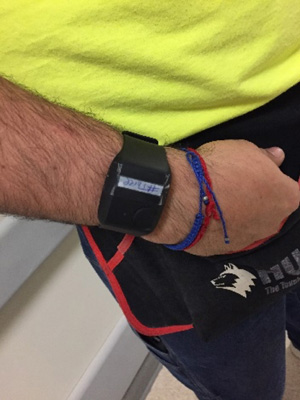
Getting smart about construction safety
A Q&A with the professor who wants to fit construction workers with health-monitoring sensors.

A Q&A with the professor who wants to fit construction workers with health-monitoring sensors.
The construction industry, by its nature, can be dangerous. SangHyun Lee, an associate professor in the University of Michigan’s Department of Civil and Environmental Engineering, says wearable sensors can improve construction worker safety and also reduce costs through better data on worker health.

Lee: Construction is labor intensive and has the highest number of accidents among all U.S. industries. Many workers wind up leaving construction jobs without enjoying their full career due to injuries or stressful environments.
In addition, construction is struggling to recruit younger workers. It lacks a skilled workforce and that jeopardizes ongoing infrastructure rehabilitation. These wearables can be used to monitor the physical and mental stress of workers so that any potential problems can be understood and, eventually, fixed.
EEG data gives researchers a sense of a worker’s emotional state, and high stress levels can be indicative of unsafe behaviors.
It’s hard for a construction worker to carry any monitoring devices or to stop their labor to provide data. But wearables, like a wristband, can be worn without interfering in that work while continuously sending back data. And with the opportunity for haptic feedback, they can be used for important communication, such as safety alarms.
These wearables can be used to monitor the physical and mental states of workers so that any potential problems can be understood and, eventually, fixed.
SANGHYUN LEE
associate professor of civil and environmental engineering
Lee: Some construction companies take steps like having workers stretch before starting the day to reduce the potential for accidents and injuries. They can also provide training to encourage employees to operate safely. So, any improvement for the workers can be directly beneficial to construction companies.
Adding sensing technology could lower insurance premiums since many insurance companies provide discounts if companies engage in activity aimed a reducing workplace injuries and accidents.
Like a patient in healthcare, we can monitor workers’ physical and mental status to identify red flags. However, this does not mean all that data has to be shared with management, which touches on worker privacy concerns. Workers could be empowered to monitor their own status.
Lee: Much of the technology has become truly “wearable” (e.g. comfortable and small-sized) and the sensors, along with advanced signal processing and machine learning, have become capable of operating at a certain standard of accuracy and robustness. Currently, we’re seeing these technologies utilized most in the healthcare field.

Lee: My research applies advanced signal processing and machine learning techniques to derive useful information from wearables. For example, my research group identifies stress, physical demands, risk perception level and other factors from a simple wristband monitor. Sensors track heart rate, skin temperature and electrical activity on the skin.
I work with several construction companies to see how useful these technologies are for worker safety and health.
Lee: I’ve spoken with many construction companies and their workers, as well as insurance companies. Everyone sees the potential to improve construction safety and health. But they all want to see successful cases of return on investment, which we’re working on.
In terms of the workers, one interesting finding has been older workers would like to see how the technology is useful to them, e.g. actual safety improvements. Younger workers are already familiar with wearable technologies and already see the value. However, they’re willing to wear them if their co-workers are using them, which is more about social influence.
Multiple strategies for the adoption of wearable sensing technology might be useful – targeting different demographics with different approaches.